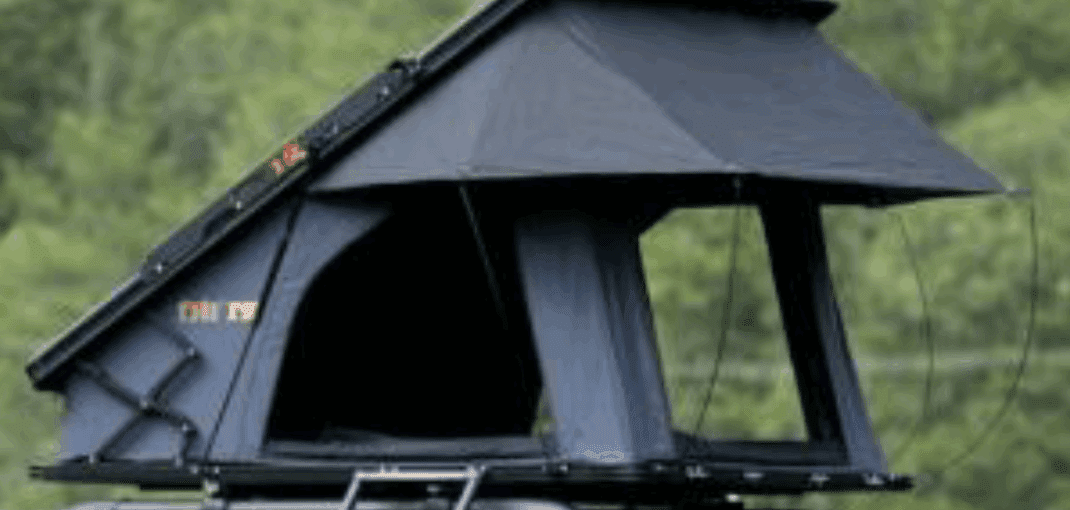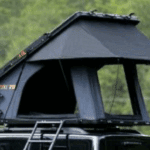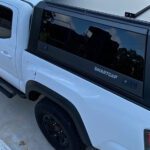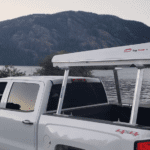The newest wedge hard-shells don’t close flat at the hinge. Instead, the hinge end pops up a few inches, creating a raised foot/ head box when open and leaving enough closed height to keep bedding inside. On-trail, it feels less coffin-like at the low end, sits calmer in wind than big fold-outs, and sets up stupid fast.
Why people love this design
- Usable room at both ends. That pop-up hinge gives real head/foot space instead of a dead taper.
- Bedding stays in. Extra closed height = pillows/duvet live inside. Less repack, faster camp breakdown. (A lot of the new wedges are built for this.)
- Fast, wind-stable setup. Gas-strut clamshell action: flip, ladder, done. Wedge geometry keeps fabric area small, so it’s steadier in coastal gusts than big soft shells.
- Slim travel profile + rails. Most of the modern shells close ~7–8″ and ship with T-tracks/crossbars for solar, boards, or cargo.
What people don’t like
- Weight & price. Hard-shells run heavier/costlier than soft shells; plan around your rack’s dynamic rating and handling. Specs vary widely (~130–215 lb by model/size).
- MPG reality. Any RTT dings fuel economy; slim shells help, but highway speed and mounting height matter more than marketing. (Independent roundups note double-digit hits are common.)
- Tall-sleeper fit. If you’re 6’2″+, check mattress length (target ~79–81″) and crawl in to feel the footbox. Kabari/Falcon specs are good baselines.
- Condensation still exists. Look for lined lids, anti-condensation mats, and upper vents, and learn a simple airflow routine for wet Island nights.
What’s new in 2024–2025
- Dual-lift/raised-hinge geometry. The little pop-up at the hinge is the whole point: a more usable interior without going box-style. (Enthusiasts search for “wedge with pop-up front.”)
- Clearer spec sheets. More brands now publish foot-end height, mattress length, closed height, and track/bar-spread so you can match racks cleanly.
- Accessory-first roofs. Integrated T-tracks/crossbars are increasingly standard, so solar/boards mount without hacks.
Buyer’s quick checklist
- Bar spread & ratings. Confirm your rack’s dynamic rating and the tent’s track spacing/min spread before you buy.
- Closed height goal. If you want bedding to stay inside, target shells ~7–8″ closed and verify interior clearance claims.
- Your height vs mattress. 79–81″+ beds suit taller campers; check footbox feel in person.
- Venting plan. Prioritize lined lids, anti-condensation mats, and upper vents; learn the airflow routine.
Bottom line
If you want speed, real space at both ends, bedding-in-place, and a low, quiet travel profile, the extended-wedge (raised footbox) clamshell is the 2025 sweet spot. Start with models that publish footbox height and rack-spread numbers so you’re not guessing.
Need help choosing?
Here at Kermode Overland, a Vancouver Island–based, locally owned shop. We’ve been in camping/overlanding for 10+ years, and we use and install this gear before we recommend it. We stock or source rooftop tents, bed racks, cross bars, awnings, portable fridges, and everything you need for a cozy, dialled setup. Questions about fitment, rack limits, or even trip ideas around the Island? Call 250-740-1844, we’ll get you sorted.






